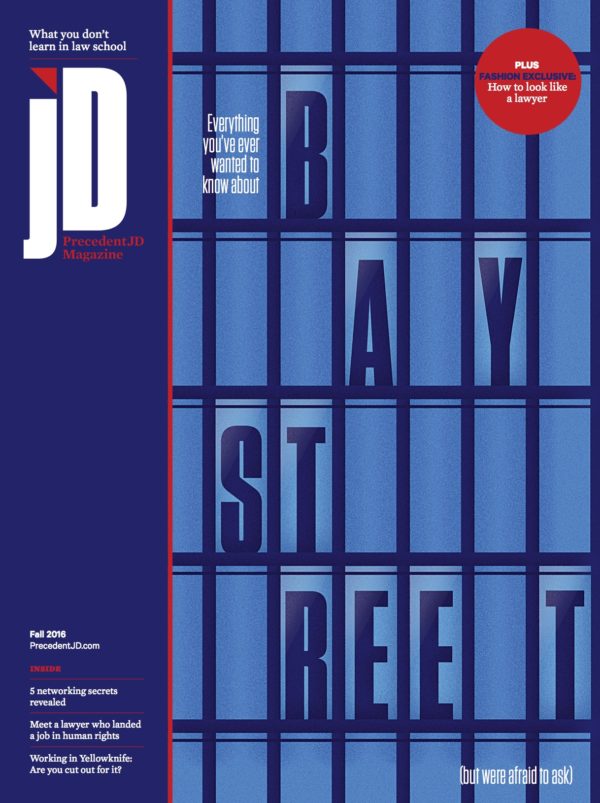
It’s easy to pine for the days, well before the economic crash of the past decade, when articling students and junior associates were a key tenet of the big-firm business model. “In those days, top firms were eager to expand their crop of students and young lawyers,” says Jordan Furlong, a consultant at Law21 and a shrewd observer of the legal profession. “Firms could bill them out at hourly rates that were far lower than what partners charged, but high enough to cover overhead and make a tidy profit.”
That formula is now obsolete. The main reason? Most corporate clients at out refuse to pay top dollar for students to perform the rote work — due diligence on corporate mergers, for instance — that used to make up the bread and butter of a student’s workload. Instead, explains Furlong, corporations expect firms to outsource that work to accounting firms or contract lawyers, who will work for less than what firms need to bill to turn a profit. “Lots of corporations,” adds Furlong, “are also doing more and more routine legal work in-house that never gets to law firms at all.”
It’s no surprise, then, that the student job market on Bay Street continues to plummet. Since 2010, the number of articling positions at the 16 historically largest law offices in Toronto fell from 322 to 255 — a 21-percent decline. “And I don’t think that this trend has bottomed out,” explains Furlong. “So we aren’t going to go back to the way things were.”
That’s something to lament. “We know students carry high levels of debt after graduation,” says Lorne Sossin, the dean at Osgoode Hall Law School. “Working at the big firms comes with high remuneration that can help pay it off. Articling at these big firms offers some of the best-in-class training. It has so much to offer students.”
But there is an upside. The biggest firms on Bay Street are hiring back a record percentage of their articling students as associates. This spring, 82 percent of students landed a first-year job. That number, by contrast, has hovered around the mid-to-high-70s for the past seven years.
“I may have one more upside,” says Furlong. “For decades, students have put so much effort into working at the largest firms — for the money, and for the perceived prestige and status that comes from working at them. But it’s not healthy to discount other careers.” He hopes that, as the highway to Bay Street gets harder to merge onto, students think about where they really want to work. “That would be a positive side effect.”
Things past
A firm-by-firm breakdown of Bay Street’s student job market reveals a clear trend: over the past seven years, the number of articling jobs has plummeted, but the probability of getting hired back has never been higher.
| Firm | Number of articling students in 2010 | Number of articling students in 2016 | Hireback rate in 2010 | Hireback rate in 2016 |
|---|---|---|---|---|
| Blakes | 34 | 32 ↓ | 90% | 86% ↓ |
| BLG | 29 | 21 ↓ | 68% | 70% ↑ |
| McCarthys | 29 | 20 ↓ | 67% | 94% ↑ |
| Osler | 29 | 16 ↓ | 100% | 93% ↓ |
| Davies | 22 | 11 ↓ | 67% | 90% ↑ |
| Stikemans | 21 | 17 ↓ | 68% | 87% ↑ |
| Torys | 18 | 15 ↓ | 94% | 100% ↑ |
| Gowling WLG (previously Gowlings) | 18 | 16 ↓ | 80% | 60% ↓ |
| Norton Rose (previously Ogilvy Renault) | 17 | 20 ↑ | 69% | 63% ↓ |
| Bennett Jones | 17 | 16 ↓ | 71% | 93% ↑ |
| Cassels | 17 | 17 = | 63% | 88% ↑ |
| Faskens | 16 | 12 ↓ | 81% | 82% ↑ |
| Goodmans | 14 | 13 ↓ | 75% | 100% ↑ |
| Dentons (previously FMC) | 14 | 14 = | 54% | 69%↑ |
| Department of Justice | 14 | 4 ↓ | 100% | 100% = |
| McMillan | 13 | 11 ↓ | 67% | 60% ↓ |
| Total | 322 | 255 ↓ | 77% | 82% ↑ |

This story is from the 2016 edition of PrecedentJD Magazine
